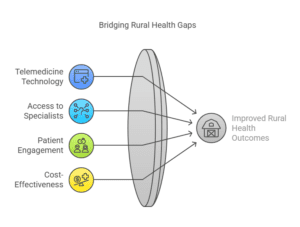Rural communities often face significant challenges in accessing quality healthcare due to geographical barriers, limited healthcare infrastructure, and a shortage of healthcare professionals. These challenges contribute to health disparities in rural areas, where patients may have limited access to specialists, longer wait times for care, and difficulty receiving timely treatment. Telemedicine has emerged as a transformative solution, addressing many of these disparities by providing remote access to healthcare services and reducing the need for patients to travel long distances to see healthcare providers.
In this article, we’ll explore how telemedicine is bridging the gap in healthcare access, improving patient outcomes, and reducing health disparities in rural communities.
Why Rural Health Disparities Exist
Rural areas often face health disparities that stem from a combination of factors, including:
- Geographic isolation: Rural communities often lack nearby healthcare facilities, forcing patients to travel long distances for basic care or specialty services.
- Healthcare workforce shortages: Many rural areas struggle with a shortage of healthcare professionals, including doctors, specialists, nurses, and mental health professionals.
- Limited healthcare infrastructure: Rural areas may lack the necessary healthcare resources and technologies, making it harder to diagnose, treat, and monitor patients effectively.
- Higher rates of chronic conditions: Rural populations often have higher rates of chronic conditions, such as diabetes, hypertension, and respiratory diseases, yet have fewer healthcare resources to manage these conditions.
Telemedicine offers a potential solution to these challenges by providing access to healthcare services remotely, reducing the need for travel, and improving the availability of healthcare professionals in rural areas.
How Telemedicine Helps Address Rural Health Disparities

1. Expanding Access to Healthcare Providers
Telemedicine allows rural residents to access healthcare providers remotely, improving their access to primary care and specialized services. Key benefits include:
- Access to specialists: Rural patients often have limited access to specialists, but telemedicine allows them to consult with specialists remotely, ensuring they receive expert care without the need to travel long distances.
- Improved care coordination: Telemedicine enables better coordination between primary care providers, specialists, and other healthcare professionals, ensuring that patients receive comprehensive care.
- Timely interventions: With telemedicine, rural patients can receive timely consultations and medical advice, reducing delays in care and preventing health issues from worsening.
2. Reducing Travel Barriers
Traveling long distances to access healthcare can be a major barrier for rural patients, especially those with limited transportation options. Benefits of reducing travel barriers include:
- Convenience: Telemedicine eliminates the need for patients to travel long distances, making healthcare more accessible and convenient for rural populations.
- Cost savings: By reducing the need for travel, telemedicine helps patients save on transportation costs and time, allowing them to focus on their health.
- Improved patient compliance: When healthcare services are more accessible, patients are more likely to keep their appointments, follow treatment plans, and manage their conditions effectively.
3. Enhancing Preventive Care
Telemedicine can help improve preventive care in rural areas by making it easier for patients to access regular check-ups, screenings, and early interventions. Key benefits include:
- Regular health monitoring: Rural patients can receive remote monitoring for chronic conditions, allowing healthcare providers to detect issues early and prevent complications.
- Health education and counseling: Through telemedicine, healthcare providers can offer counseling and education on topics such as smoking cessation, weight management, and chronic disease prevention, empowering rural populations to take control of their health.
- Chronic disease management: Telemedicine enables continuous management of chronic conditions, such as diabetes, hypertension, and asthma, ensuring that patients receive ongoing care and support.
4. Overcoming Healthcare Workforce Shortages
Rural areas often experience a shortage of healthcare professionals, which can lead to long wait times for appointments and limited access to care. Telemedicine helps address this issue by:
- Remote consultations with specialists: Telemedicine allows rural patients to consult with healthcare professionals from urban centers, alleviating the strain on local healthcare providers and improving access to specialized care.
- Attracting healthcare professionals: By offering telemedicine services, rural healthcare facilities can attract healthcare professionals who may prefer remote work arrangements, helping to address workforce shortages.
- Expanding healthcare reach: Telemedicine enables healthcare providers in rural areas to offer a broader range of services, from mental health consultations to dermatology, without the need for in-person visits.
5. Providing Access to Mental Health Services
Rural areas often face a shortage of mental health professionals, and mental health care is frequently overlooked in these communities. Telemedicine has a significant impact by:
- Remote mental health consultations: Telemedicine allows rural patients to access mental health professionals through video calls, offering counseling, therapy, and psychiatric services without leaving their communities.
- Reducing stigma: Patients may feel more comfortable seeking mental health care remotely, helping to reduce the stigma associated with seeking therapy or counseling.
- Increasing access to resources: Telemedicine provides rural residents with access to mental health resources, including support groups and educational materials, helping to improve overall mental well-being.
6. Improving Healthcare Delivery in Emergencies
Telemedicine can play a crucial role in rural areas during medical emergencies by providing real-time consultations with healthcare providers. Benefits include:
- Emergency consultations: Rural patients experiencing medical emergencies can receive immediate advice or consultation from healthcare providers, helping to triage the situation before a patient is transferred to an emergency facility.
- Remote monitoring: For patients in critical conditions, telemedicine allows for remote monitoring by healthcare professionals, enabling real-time interventions and reducing the need for emergency room visits.
- Telemedicine in disaster response: In rural areas impacted by natural disasters or public health crises, telemedicine provides an essential means of delivering care, coordinating resources, and managing patient flow.
Conclusion
Telemedicine is a powerful tool in addressing rural health disparities by improving access to healthcare, reducing travel barriers, enhancing preventive care, and overcoming healthcare workforce shortages. By providing remote consultations, continuous monitoring, and improved care coordination, telemedicine is helping to ensure that rural residents receive the same level of care as those in urban areas. As telemedicine continues to expand, it will play a crucial role in reducing health disparities and improving the overall health and well-being of rural populations.
What People Are Asking
1. How does telemedicine help rural communities access healthcare?
Telemedicine improves access to healthcare by allowing rural patients to consult with healthcare providers remotely, reducing the need for travel and providing access to specialists.
2. Can telemedicine help with chronic disease management in rural areas?
Yes, telemedicine allows for remote monitoring and management of chronic conditions, such as diabetes and hypertension, ensuring that rural patients receive ongoing care and support.
3. How does telemedicine reduce the impact of healthcare workforce shortages in rural areas?
Telemedicine allows rural healthcare facilities to connect with specialists remotely, alleviating the strain on local providers and expanding access to care.
4. Can telemedicine be used for mental health services in rural areas?
Yes, telemedicine provides rural residents with access to mental health professionals for counseling, therapy, and psychiatric services, helping to address mental health disparities.
5. How does telemedicine improve emergency care in rural areas?
Telemedicine enables real-time consultations for emergency situations, allowing healthcare providers to assess and manage patients remotely, reducing the need for hospital visits and ensuring timely interventions.
Disclaimer
For informational purposes only; not applicable to specific situations.
For tailored support and professional services,
please contact Staffingly, Inc. at (800) 489-5877
Email: support@staffingly.com.
About This Blog: This Blog is brought to you by Staffingly, Inc., a trusted name in healthcare outsourcing. The team of skilled healthcare specialists and content creators is dedicated to improving the quality and efficiency of healthcare services. The team passionate about sharing knowledge through insightful articles, blogs, and other educational resources.
 Book a Demo to Build Your Team Today!
Book a Demo to Build Your Team Today!

 Read Case Studies
Read Case Studies 



 Virtual Medical Assistants
Virtual Medical Assistants



